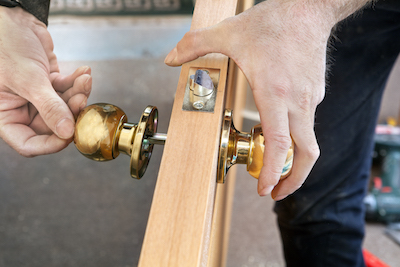
It may appear that sanding, planing, or otherwise cutting the door down to a smaller size is the most natural method to fix it. But, especially with hollow-core interior doors that don’t respond well to planing or sanding, this can be more difficult than it appears. Other types of doors, such as metal or fiberglass, cannot be trimmed down. As a result, when you’ve explored all other options, you should consider lowering the size of the door.
Fortunately, there are a few simple, low-cost solutions for misaligned doors. You won’t have to reinstall the door or entirely rebuild it. Readjusting the hinge or latch may be all that is required in some circumstances.
What You’ll Need
Equipment / Tools
- Phillips screwdriver
- Cordless drill with bits
- Pencil
- Fluted countersink bit
- Wood chisel
- Carpenter’s glue
- Electric sander
Materials
- 2-inch screws
- 2-1/2-inch brass screws
- Wood dowel
Instructions
Continue reading for easy-to-follow instructions on how to fix your misaligned door.
Hinge Screws Should Be Tightened
The top hinge screws on the door may need to be tightened if the door is misaligned and scrapes against the door jamb’s side near the top.
Tighten the three screws that connect the hinge to the jamb and the three screws that hold the hinge to the door using the Phillips screwdriver. Even if you can just turn the screws a little, this may be enough to tighten the hinge.
Hinge Screws Should Be Replaced
Hinge screws are typically 1 inch long or less. Because the screws would protrude through the jamb of pre-hung doors, this is not an option. However, after the door is in place, the short screws can be replaced with longer screws.
Screw One or Two Screws into The Door Jamb.
If you haven’t been able to draw the hinge in, tighten the latch-side door jamb next. Because the screws will be visible, brass or any other type of screw that blends into the door jamb is usually a good choice.
Determine which parts of the door jamb are in conflict with the door. Make a pencil mark. Begin by drilling a pilot hole. Change to the fluted countersink bit next. To avoid tearing out the hole, take caution with this step.
The head of the screw should eventually be flush with the door jamb. Finally, screw the pilot hole into the screw.
Tighten Strike Plate
The striking plate (the metal plate on the door jamb) might become loose with time. The strike plate will scrape against the door latch as long as it protrudes.
Tighten the screws on the strike plate using a manual Phillips screwdriver or a cordless drill. Replace the screws with 2-inch screws if they are too loose to hold in the door jamb.
Move the Strike Plate in Small Increments.
When the door appears to be out of alignment, it’s often due to the latch failing to meet the striking plate. It’s possible that the striking plate is set too high. It is not feasible to raise the door latch. With a hammer and screwdriver, you can move the strike plate progressively (1/32-inch or so).
To begin, loosen the strike plate screws. Then, insert the screwdriver blade into the hole in the strike plate. To force the strike plate down, hit the top of the screwdriver with the hammer.
Strike Plate should be moved.
If you need to move the strike plate more than 1/32-inch, you’ll need to remove it and replace it with new screw holes.
The current screw holes will interfere with the new screw holes, which is a problem. When you drive the screws in, they will restore to their original positions. Filling in the old holes is the solution.
- Purchase a 1/8-inch wood dowel that is the same diameter as the screw holes.
- Remove the strike plate from the door.
- Cut two 1-inch long pieces of dowel off the dowel.
- Apply a dab of wood glue to one end of each dowel and push it into the existing screw holes.
- Tap the dowels into the holes more gently.
- Allow four hours for the glue to dry.
- Cut the dowels flush with the surface.
- Transfer the strike plate to its new location.
Inset Strike Plate Deeper Into Jamb
You can set the strike plate deeper into the door jamb if the strike plate scrapes against the door or if the door latch and other solutions haven’t worked.
Completely remove the strike plate. Chip away wood from the jamb inset with a sharp wood chisel. Don’t take too much wood out. Replace the striking plate and give the door a once-over.
Sanding Down the Door
Remove the door from the hinges to shave down a portion of it. To avoid hurting the door’s side, prop it up on soft materials like towels.
Because an electric sander is easier to manage than a plane or saw, it is the greatest option for slimming down doors. Only sand the latch side of the door, not the hinge side.
Determine the material’s kind. Interior hollow core doors have a soft finger-jointed fine that can be sanded down. However, take it slowly to avoid removing too much wood.
Need Help?
If you believe it may be better to completely replace your door and need help, contact Moldings Plus at (909) 947-3310 to schedule a showroom consultation today!



